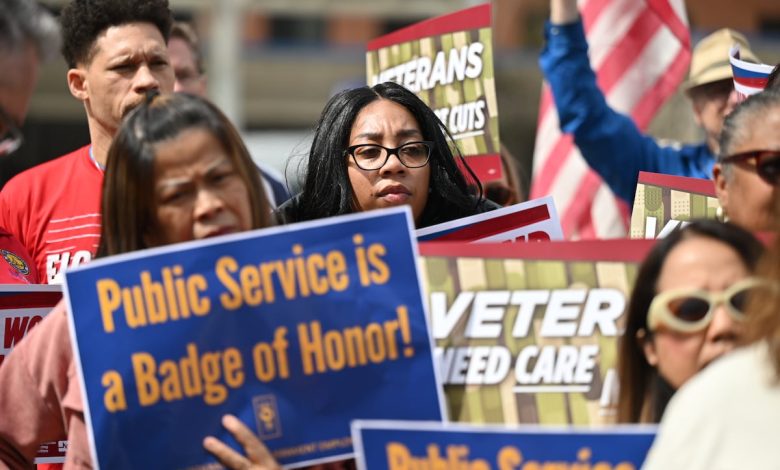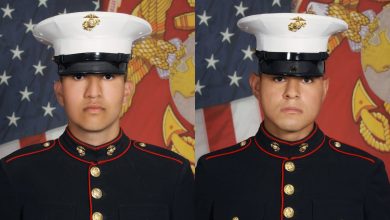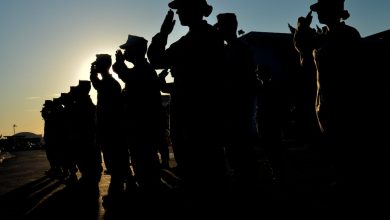Nurses rally outside VA hospitals to highlight staff cuts, vacancies

During a typical nursing shift at VA Medical Center San Diego, Andrea Johnson said she barely has time to catch her breath between room checks, family consults and patient requests.
“What happens if you cut housekeeping staff, and it falls to us to get rooms cleaned?” she asked. “If dietary staff is cut, will nurses have to take on the responsibility to deliver meal trays? Who is going to handle scheduling to make sure a bed is available?
“All of those things affect our time and our ability to care for our veterans.”
Johnson, a seven-year employee of VA, was one of dozens of department nurses rallying outside the California hospital Wednesday to protest an array of moves by President Donald Trump’s administration that they say unnecessarily threatens the health of veterans and federal workers.
The event, planned by the National Nurses Organizing Committee and National Nurses United, or NNU, followed similar protests in New York, Chicago, North Carolina and other sites in recent weeks. More are scheduled through the end of the month.
“We’re not going to let them just bully the workers,” said Irma Westmoreland, an official at NNU and a VA nurse working in Georgia for the last 34 years. “We’re not going to let them do things that are illegal. We’re not going to let them just fire people for no reason.”
The rallies were originally conceived to protest looming staffing cuts across the department. VA Secretary Doug Collins has proposed trimming the workforce back to 2019 personnel levels, which would eliminate around 80,000 positions across the department.
VA officials have emphasized that those cuts will not impact services or benefits and said positions to be eliminated will not be ones which directly work with veterans or family members. In a statement, VA Press Secretary Peter Kasperowicz dismissed the protests as fear-mongering and exaggeration.
“Positions that are critical to providing care to veterans — including nursing positions — will not be affected by efforts to make VA more efficient,” he said. “VA’s focus is on streamlining administrative functions, eliminating redundancies, and reducing managerial administration burdens without hurting veteran care.”
But nurses like Johnson and Westmoreland — and Democratic lawmakers critical of the plans — insist worker cuts of that scale will inevitably hurt veterans’ care, even if the effects are indirect.
“We’re already spread way too thin,” said Beverly Simpson, a VA nurse who works in West Virginia. “Any more cuts or responsibilities affects the quality of the health care that the veterans receive, and it makes so much more room for errors to occur.”
Officials from NNU have lamented VA’s nurse hiring practices for years, saying the department has not been aggressive enough in properly staffing hospitals to meet growing needs.
Now, they said, the problem is getting even worse.
Trump announced a federal hiring freeze earlier this year, but exempted some critical jobs like VA health care posts. However, NNU leaders have said the uncertainty over future job cuts has led many members to start seeking jobs elsewhere and is discouraging potential recruits.
VA leaders dispute those claims. They said of the 91,000 nursing jobs in the VA system, about 8,800 are unfilled now — a vacancy rate lower than most other major medical systems.
“There is a nationwide shortage of nurses that makes recruiting and retention difficult across the health care sector,” Kasperowicz said. “We continue to demonstrate the ability to attract nurses to VA, and we have hired more than 1,600 nurses in the first half of [fiscal] 2025.”
He also challenged union officials to provide details of personnel shortages to VA management, so those problems can be addressed. Union officials said past complaints about the problems have gone unanswered.
Further complicating the conflict are White House moves to scale back federal union protections. As those collective bargaining fights are being debated in court, the nurses’ rallies have grown to include a coalition of other federal workers, local union representatives and several veterans advocacy groups.
Department officials said final plans for VA jobs cuts are still being developed and reviewed, with an eye toward preventing problems in benefits and health care delivery.
In a social media post just a few days after the first nurses rally, Collins said that too many critics “view the VA as a federal jobs program” and are pushing instead to “maintain a dysfunctional status quo” at the department.
“Our shared goal needs to be making things better for veterans rather than protecting the department’s broken bureaucracy,” he said.
But those assurances have not won over the nurses protesting outside VA locations. Officials said they will keep holding the events until their concerns are heard, and until a sensible plan for VA staffing levels is made public.
“When the unions band together with the community, there isn’t anything we can’t accomplish,” Westmoreland said. “We’re going to stop this. We’re going to make sure that our VA is safe for our veterans.”
Leo covers Congress, Veterans Affairs and the White House for Military Times. He has covered Washington, D.C. since 2004, focusing on military personnel and veterans policies. His work has earned numerous honors, including a 2009 Polk award, a 2010 National Headliner Award, the IAVA Leadership in Journalism award and the VFW News Media award.
Read the full article here







